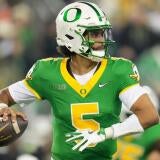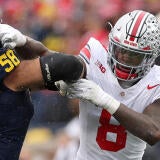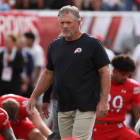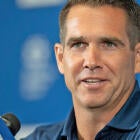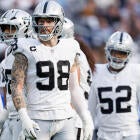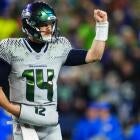2024 NFL Draft: How teams use data to build their boards, from athletic evaluation to cognitive assessment
Clubs are digging into any possible edge they can get

The NBA and MLB have been far ahead of the NFL in terms of using data and analytics in a major way for their player personnel, scouting and roster building processes, but that trend is changing quickly among NFL buildings.
Some teams, such as the Cowboys, Eagles, Ravens, Vikings and Browns, among others, greatly value their analytics team and involve them frequently. But all 32 teams have put in the financial and personnel resources to involve data throughout their process over the last five years.
You'll often here about it being "just a piece of the puzzle" or "one factor to consider," but the teams that use data and analytics best are the ones that don't qualify or push to the side, but involve them the same way venture capital firms assess start-ups: as an integral part of their decision-making ecosystem.
Athletic Evaluation
Evaluating a player's athleticism is one of the most crucial tasks for a college area scout, and often times, people outside the league don't fully appreciate how important it is to have "NFL athletes" on a football team.
Teams still greatly value NFL Scouting Combine data from things like 40-yard dash times, shuttles, broad/vertical jumps, etc. because of the comparability and stability of that data: NFL teams conceptually know what a 4.40 means and how a player who runs that speed may translate in the NFL.
But teams also go beyond just the combine testing data they get in February and March. Teams will use services such as Tracking Football, which collects and organizes high school track and field data (as well as high school combine data) to give teams perspective on a player's history as an athlete and how explosive/fast he may be.
Teams also have gotten much more sophisticated in their use of player tracking data from companies like Zebra, who can quantify how fast or explosive a player is on the field, in game action, and with pads on.
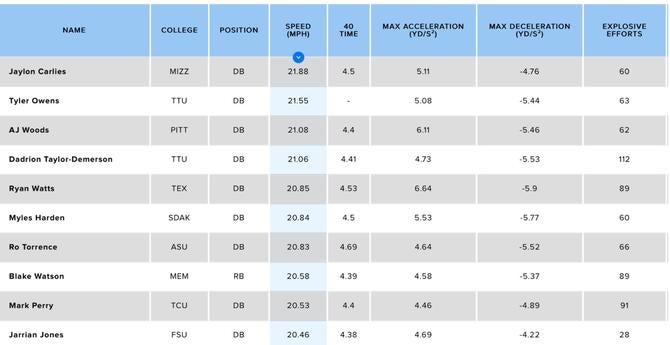
*Example of player tracking testing data from the 2024 East-West Shrine Bowl
With almost 10 years of this information being collected, organized and digested by NFL scouts and decision-makers, we're finally in an era of football evaluation where scouts feel comfortable and understand what these numbers mean, and have historical context for how a player's miles per hour or max acceleration may translate to the NFL.
Statistical Analytics
This is the most proprietary and team-by-team dependent of any of the data-based analysis a team will use, and easily where teams differ the most. Teams blend athleticism and statistical analysis to put together "composite" scores, but how teams' weight certain statical elements is most unique between teams.
Teams' analytic departments can use simple things such as snap counts overall and by position to simplistic statistical categories like yards after contact for running backs, total pressures for pass rushers, etc.
But many of the more sophisticated teams can dive deeper, using advanced tracking stats from companies like PFF and Sports Source Analytics to evaluate how players perform in unique situations (i.e. press coverage snaps, advanced quarterback charting and more), to have a better conceptual sense of who players were at the college level.
The goals for statistical analysis greatly differ, too. Some teams value statistical analysis primarily for talent identification, with the goal of "let's make sure our scouts are watching and focusing on the right players." Other teams use it more critically on ranking players, weighing it alongside a player's film/scout grade evaluations. Finally, teams (as well as our scouting team at the Shrine Bowl) use it as a risk assessment measure: What does this player's statistical profile mean for their likelihood of being (or not being) a capable NFL player.
Cognitive Assessment Information
Historically, NFL teams have utilized player testing to capture intelligence and personality types, but over the last five or so years, the perception of what non-football testing should be has radically changed. NFL teams, wisely so, have focused much more on what an athlete's cognitive abilities, both strengths and weaknesses, are and how they process information.
The three most predominant cognitive assessments, the AIQ, S2 and HRT, all test players during the draft process. While these tests have different means, processes and technologies to assess players, each has the goal of giving NFL teams a sneak peak of what that player may be once they get them in their building, from things such as how the learn and how they react to stimuli.
These tests are most immediately focused on by NFL teams for two key areas: players with perceived cognitive, attentiveness or reactionary questions, and quarterbacks. But over the last few years, NFL teams have taken the next step, bringing in experts from companies like AIQ and S2 during the draft process to talk through their top players' results, what it means, and helping them paint the picture for how these players may fit into their locker room.
For some teams, cognitive assessments are becoming one of the most important non-film evaluation tools available to them.
Historical Trends
Lastly and most prevalent in the weeks leading up to the NFL Draft, teams try to use historical and team-drafting data to get a sense for how the draft may go. This means looking at how many players per position are drafted (and what the trend line is), changes league-wide in roster construction, and individual team drafting-based trends.
Teams want to get a sense of what other teams may do at every round of the draft, as properly assessing value allows them to take the players they want as late as they can to maximize value.
For example, the 2023 NFL Draft had a near record low of off-ball linebackers. That may mean more linebackers will be drafted than a team's draftable player board may have, meaning there could be more players at a different position available to them in the 2024 draft.
Additionally, teams are forecasting changes league-wide as well as individual team drafting strategy based on changes to their scheme and the major NFL rule change that passed this year: the new NFL kickoff.
The smartest teams try to eliminate their own bias (i.e. who they like) when assessing what other teams may do. And while some of their intel comes from scouts on the road hearing things, tracking player workouts, and other methods, using past drafting trends and strategies is the most stable way to assess what is to come.


